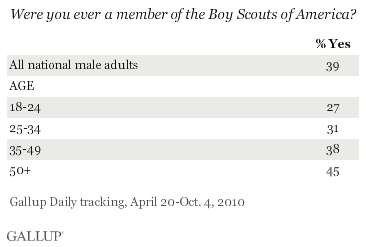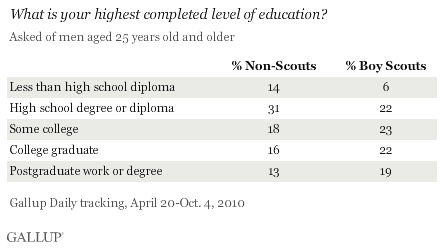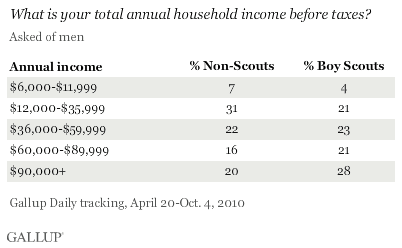WASHINGTON, D.C. -- As Boy Scouts of America celebrates its 100th anniversary, 39% of adult men in the United States tell Gallup they have been a member of the organization at one time. Fewer men in their 20s and 30s report having been in the Boy Scouts than older men, suggesting that younger generations are not joining at the same rate as previous generations.

The results are based on interviews with more than 81,000 adult males, conducted as part of Gallup Daily polling April 20-Oct. 4, 2010. Gallup asked male respondents if they were ever a member of the Boy Scouts. The resulting data could include long-term Boy Scouts as well as those who were only briefly members or who were members of the Cub Scouts or other Scout-related programs.
Despite the large proportion of American men overall who report having been Boy Scouts, the figure is 45% among men aged 50 and older, compared with 27% of men aged 18 to 24.
The Gallup data reveal that being a Boy Scout is modestly related to higher average levels of educational attainment. Among those aged 25 and older, 22% of men who have been Boy Scouts report graduating from college, compared with 16% of non-Scouts. Additionally, 19% of men who have been Boy Scouts have gone on to achieve a postgraduate education, compared with 13% of non-Scouts.

While the relationship between scouting and education is clear, the cause is not. Although it is possible that membership in Boy Scouts promotes and furthers education, it is also possible that Boy Scouts are more likely to come from more prosperous backgrounds or families that value education, or perhaps have higher levels of personal motivation that spur them on to achievement in scouting and in education.
In similar fashion, men who have been Boy Scouts also report higher annual incomes on average than non-Scouts. Twenty-eight percent of former Boy Scouts report an annual income of $90,000 or more, compared with 20% of non-Scouts. At the same time, 7% of non-Scouts report making less than $12,000 per year, compared with 4% of men who have been Boy Scouts.

Again, as with the education findings, the direction of causality between being a Boy Scout and income level in adulthood cannot be established with these data.
Bottom Line
Gallup data confirm what Boy Scout leadership likely already knows -- that the organization has experienced a proportional membership decline among younger generations. The data also show that men who have been Boy Scouts generally report somewhat higher average educational attainment and income than those who have not been Boy Scouts.
As one of the best known voluntary associations for youth in the United States, Boy Scouts of America has influenced a large proportion of men in the United States. To maintain its influence in the next era, it must address the dwindling membership seen among younger generations.
In collaboration with Baylor University and with funding from the John M. Templeton Foundation, Gallup is collecting nationally representative data to further understand what types of Americans engage in Boy Scouts and the impact of scouting on youth development in the United States.
Results are based on telephone interviews conducted as part of the Gallup Daily tracking survey April 20-Oct. 4, 2010, with a random sample of 81,409 adult men, aged 18 and older, living in all 50 U.S. states and the District of Columbia, selected using random-digit-dial sampling.
For results based on the total sample of national adult men, one can say with 95% confidence that the maximum margin of sampling error is ±1 percentage point.
For results based on the total sample of 36,427 former Boy Scouts, one can say with 95% confidence that the maximum margin of sampling error is ±1 percentage point.
For results based on the total sample of 44,982 non-Scouts, one can say with 95% confidence that the maximum margin of sampling error is ±1 percentage point.
Interviews are conducted with respondents on landline telephones and cellular phones, with interviews conducted in Spanish for respondents who are primarily Spanish-speaking. Each daily sample includes a minimum quota of 150 cell phone respondents and 850 landline respondents, with additional minimum quotas among landline respondents for gender within region. Landline respondents are chosen at random within each household on the basis of which member had the most recent birthday.
Samples are weighted by gender, age, race, Hispanic ethnicity, education, region, adults in the household, cell phone-only status, cell phone-mostly status, and phone lines. Demographic weighting targets are based on the March 2009 Current Population Survey figures for the aged 18 and older non-institutionalized population living in U.S. telephone households. All reported margins of sampling error include the computed design effects for weighting and sample design.
In addition to sampling error, question wording and practical difficulties in conducting surveys can introduce error or bias into the findings of public opinion polls.
For more details on Gallup's polling methodology, visit https://www.gallup.com/.
